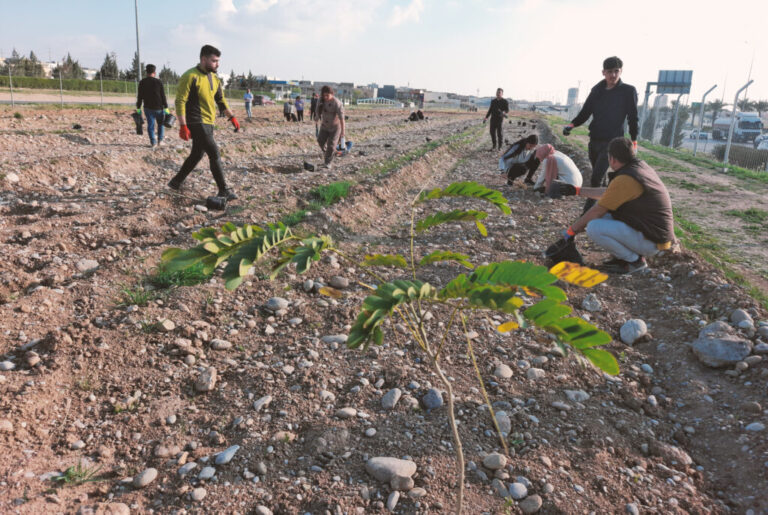
Overview:
In an ambitious effort to combat desertification, Freshly and partners planted 10,000 native trees across Northern Iraq.
In This Article:
- Locations and species: oak, pistachio, and mulberry in highland zones
- How schools and farmers volunteered time and land
- Impact metrics: biodiversity boost, soil restoration, and carbon offset
- Challenges faced during drought and how drip irrigation made it work
Key Insight:
Small seedlings, big impact—this project proves what’s possible when community and climate goals align.
About The Article
2024 Reforestation Project: 10,000 Trees Planted
Rebuilding Kurdistan’s Green Landscape, One Tree at a Time
In an ambitious effort to combat desertification and enhance biodiversity in Northern Iraq, Freshly partnered with local communities, environmental NGOs, and government agencies to plant 10,000 native trees across the region. This reforestation project is part of a larger initiative to restore the natural environment, protect soil health, and provide a long-term solution to the ongoing challenges posed by climate change.
This article delves into the locations, species, and community involvement that made this project a success. It also highlights the environmental and social impacts, and the efforts made to ensure the survival and growth of the trees in the face of Kurdistan’s harsh climate.
- Locations and Species: Restoring the Highlands
The project targeted key areas in Northern Iraq, particularly in the highland zones where desertification has been spreading rapidly. The selected regions included areas around Dohuk, Erbil, and parts of the Sulaymaniyah governorate.
The native species chosen for planting were selected for their resilience in the region’s dry conditions. These species include:
- Oak trees: Known for their strength and long lifespan, oaks will provide shade and shelter for local wildlife.
- Pistachio trees: A staple of the region’s economy, pistachios are drought-resistant and will help regenerate soil quality while providing a source of income for local farmers.
- Mulberry trees: These trees support local biodiversity by attracting insects and providing food for birds and other wildlife.
By planting these species, the project aims to not only restore the landscape but also encourage local wildlife to return and thrive in these once-forested areas.
- Community Involvement: A Collective Effort
One of the key aspects of the project was its emphasis on community participation. Schools, farmers, and local residents were all encouraged to get involved in planting and maintaining the trees. Volunteers donated their time and energy, working side-by-side with project staff to plant the trees in carefully selected locations.
A key highlight was the involvement of students from local schools, who were given the opportunity to learn about the importance of reforestation and environmental sustainability. They also participated in planting sessions, which helped instill a sense of ownership and responsibility for the environment in the next generation.
Additionally, local farmers were engaged in the project, with many agreeing to plant trees on their own land. This involvement not only ensured a steady supply of manpower but also strengthened the relationship between the project and local communities, fostering a collaborative spirit.
- Environmental Impact: Reversing Desertification
The ultimate goal of the reforestation project is to combat the devastating effects of desertification in the region. With soil erosion, loss of fertility, and water scarcity increasingly threatening local agricultural productivity, the project aims to restore natural balance and improve environmental conditions.
Key environmental benefits include:
- Soil restoration: The roots of the newly planted trees will help stabilize the soil, preventing further erosion and improving soil fertility.
- Carbon sequestration: Trees play a vital role in absorbing carbon dioxide and other greenhouse gases, helping to mitigate the effects of climate change.
- Biodiversity support: The new trees will provide habitats for local wildlife, promoting biodiversity and creating healthier ecosystems.
To ensure the long-term success of these efforts, the project implemented drip irrigation systems to support the trees during the first few years of growth, ensuring their survival in the face of Iraq’s harsh climatic conditions.
- Overcoming Challenges: Drought and Water Scarcity
One of the major challenges the project faced was water scarcity, a persistent issue in Northern Iraq. The region’s climate is dry, with long periods of drought that make it difficult to maintain plant life. To overcome this, the project utilized drip irrigation systems, which deliver water directly to the roots of the trees, minimizing water loss and ensuring that each tree received the necessary moisture to thrive.
Additionally, the project team worked closely with local farmers to ensure that the trees received proper care. Farmers were trained on water-efficient irrigation techniques and given the tools needed to continue maintaining the trees after the project’s completion.
- Long-Term Vision: Sustainable Reforestation
The reforestation initiative is not a one-time project but part of a larger, ongoing effort to restore Kurdistan’s environment. The success of this planting will be measured over the coming years through continued monitoring and the involvement of the local communities.
The initiative is set to expand, with plans for future tree planting campaigns aiming to restore even more areas in the region. Moreover, the trees planted will act as a living legacy that will benefit future generations, providing sustainable natural resources and environmental stability.
Key Insight:
Small seedlings, big impact—this reforestation project demonstrates that even the most ambitious environmental goals are achievable when communities come together with a shared sense of purpose. By planting 10,000 trees, we are not only reversing desertification but also ensuring a more sustainable and resilient future for Kurdistan. This project stands as a testament to the power of collective action in the face of climate challenges.
